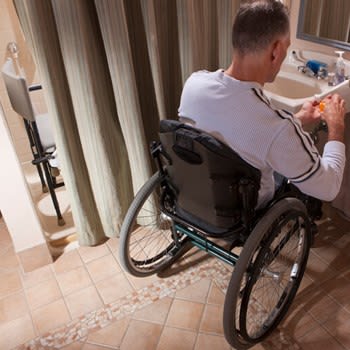Does Medicare Cover Stair Lifts?
- While Original Medicare doesn't cover stair lifts, some private insurance plans called Medicare Advantage plans may cover stair lifts or similar home modifications. These benefits aren't available with all plans, so learn more about your options.
While Original Medicare (Part A and Part B) doesn't cover stair lifts, some Medicare Advantage (Part C) plans may offer benefits Original Medicare doesn't cover. Some plans may help cover certain home modifications made to help you age in place safely at home.
Learn more about stair lifts, Medicare coverage and other considerations that may be available to you for making your home safer as you age.
When Does Medicare Pay for Stair Lifts?
Medicare Part B doesn't typically cover chair lifts because they're classified as home modifications rather than Durable Medical Equipment (DME).
Despite this, some Medicare Advantage (Medicare Part C) plans might offer benefits that Original Medicare doesn't cover. Some plans may offer benefits meant to help you age in place, including certain home modifcations.
Not all Medicare Advantage plans cover stair lifts or similar home modifications, so it's important to speak with a licensed insurance agent who can help you compare plans where you live, including what benefits they cover and what they cost.
To determine if your current plan will cover any or all of the cost for a stair lift, you'll need to investigate the coverage rules and restrictions in detail in your plan's explanation of benefits.
- Contact your insurance provider directly for information on their policies regarding stair lifts.
- Talk with local dealers who sell and install these devices. They may have insights into which insurers are more likely to provide financial support.
- If necessary, consider switching to a different plan during the annual enrollment period that offers better coverage for mobility equipment like stair lifts.
What Is a Stair Lift?
Chair lifts are an invention designed to help those with limited mobility navigate their homes more easily. It is especially useful for the elderly who may have mobility limitations.
Types of Stair Lifts: Finding the Perfect Fit for Your Home
There are three main types of stair chair lifts available for your home: straight stair lifts, curved stair lifts, and outdoor stair lifts.
Straight Stair Lifts
The most common option is the straight stair lift, designed specifically for a set of stairs going straight up or down between floors.
This type offers a simple installation process and tends to be more affordable than other options.
Curved Stair Lifts
If your staircase has curves or turns, then a curved stair lift may be more suitable.
This customized solution ensures smooth navigation around bends while providing optimal safety and comfort during use. Keep in mind that these tend to be pricier due to their tailored design.
Outdoor Stair Lifts
Last but not least, we have the durable outdoor stair lift. Built with weather-resistant materials, this option allows easy access to exterior spaces like decks, patios, or garden areas.
If you or a loved one enjoys spending time outdoors but has difficulty navigating stairs due to mobility limitations, an outdoor stair lift can provide the freedom to enjoy the outdoors once again.
Weight Limit for Stair Lifts: How Much Can They Handle?
Safety and functionality are crucial factors when choosing the right chair lift for you or your loved one.
The good news is that most straight chair lifts can accommodate users up to 160kg (approximately 350lbs).
If you need a higher weight capacity, there are other options:
- Bariatric Stair Lifts: These heavy-duty models can support weights up to 250kg (550lbs) and provide extra stability and comfort for larger users.
- Oversized Seats: Some manufacturers offer wider seats with increased weight capacities on their standard models.
FAQs
Are Stair Lifts a Good Idea?
Chair lifts are an excellent solution for elderly individuals or those with mobility issues who have difficulty navigating stairs. They provide safety, independence, and convenience by allowing users to move between floors without assistance.
However, it's essential to consider factors like cost, installation requirements, and maintenance before making a decision.
What Are the Disadvantages of Stair Lifts?
Some disadvantages of stair lifts include their cost (both initial purchase and ongoing maintenance), potential space constraints on narrow staircases, possible limitations in weight capacity or compatibility with certain types of stairs (e.g., curved), and aesthetic concerns as they may not blend seamlessly into your home's décor.
What Is the Purpose of a Stair Lift?
The primary purpose of a stair lift is to help individuals with limited mobility safely navigate between different levels in their homes.
This enables users to maintain independence while reducing the risk of falls or injuries related to climbing stairs.
Is There an Alternative to a Stair Lift?
Alternatives include ramps for wheelchair access (ADA guidelines apply), vertical platform lifts that transport users vertically alongside the staircase, elevators for residential use, or relocating living spaces to a single floor.
Conclusion
They come in various types and weight limits, making them suitable for different needs. While Medicare does not cover the cost of stair lifts, there are other options available to help with financing.
If you or someone close to you has difficulty getting around, a chair lift may be the perfect solution for providing comfort and convenience. Having a stair lift installed can provide years of safe use.





